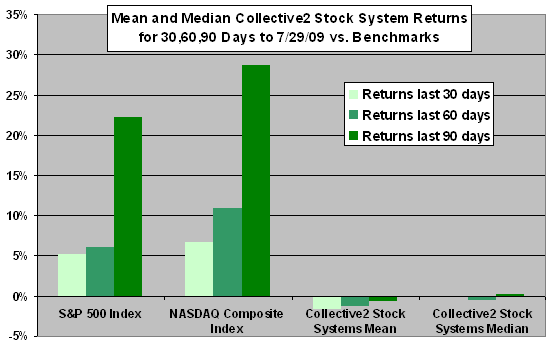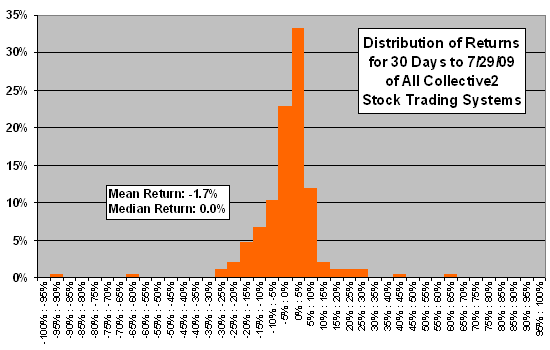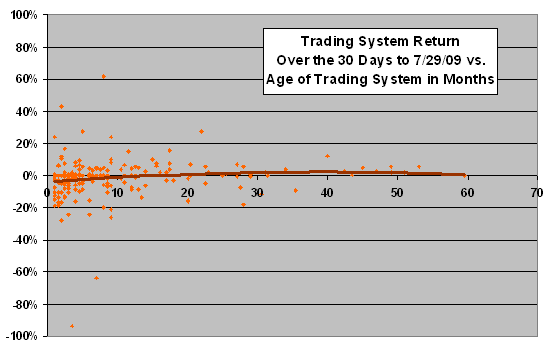According to the introduction at Collective2, the site “monitors over 8,920 trading systems. Whether you trade stocks, futures, forex, or options – you’ll find a trading strategy here… Think of us as an independent ‘trading system auditor.’ We’ll investigate which trading systems are profitable.” Additionally, Collective2 serves sellers (renters) of trading systems: “If you are an expert trader, or have developed a ‘black box’ system, you can earn income by making your trade signals available to C2’s over 32,000 registered users.” What can investors/traders learn about stock trading systems from the aggregate data compiled at Collective2? Using statistics available there for 193 active stock trading systems (as of 7/29/09) and some contemporaneous returns for the S&P 500 Index and the NASDAQ Composite Index, we find that:
Collective2 (via “The Grid”) provides an array of statistics for each active stock trading system offered. Many of these statistics cover different periods of performance for each system. For benchmarking and comparison purposes, we focus on three statistics that specify the same periods of performance for all systems: the return over the last 90 days, the return over the last 60 days and the return over the last 30 days.
The following chart compares the mean and median returns for the 193 active Collective2 stock trading systems over the past 30, 60 and 90 days (ending 7/29/09) to the contemporaneous returns of the S&P 500 Index and the NASDAQ Composite Index. The chart shows that the typical stock trading system available on Collective2 substantially underperformed the broad U.S. stock market over the past few months. Over the past 30 days, only about 18% of these trading systems matched or beat the S&P 500 Index.
Note further the following from the Collective2 disclaimer: “All performance claims on this web site must be regarded as hypothetical. …Commissions, fees, or trading system leases/subscription fees are not included in any of the results you see here. There is often a vast difference between hypothetical results and real-life trading results achievable in a real brokerage account, and real-life results are almost always vastly worse than hypothetical results.”
If this Collective2 data is representative of the short-term trading of expert individual investors, then short-term trading generally does not work well.
What else does the distribution of returns for these trading systems imply?

The next chart is a histogram of the returns of the 193 active Collective2 stock trading systems over the past 30 days (ending 7/29/09) based on return intervals of 5%. For example, 33% of the systems had returns between 0% and 5% over the past 30 days. Simple analyses indicate that this distribution has:
Negative skewness, such that most of the trading systems have negative returns over the common performance period.
Positive kurtosis (leptokurtic), such that its shape is more pointed and has fatter tails than a comparable normal distribution.
In other words, experiences with these systems are probably wilder and more negative than “normal” statistics would indicate.

The final chart relates the returns of the 193 Collective2 stock trading systems over the past 30 days (ending 7/29/09) to the duration in months of the period that Collective2 has tracked the system, ranging from one month to just under 60 months, along with a best-fit quadratic curve. The mean (median) age of these systems is 11 (6) months.
Results suggest that there is a positive survivorship bias in the sample. In other words, the returns for very young trading systems are worse than those for seasoned systems, and there are many more young systems than seasoned systems. In other words, young systems appear to have a high mortality rate due to poor performance. A possible interpretation of these results is that many “expert” traders putting their systems on Collective2 are not testing them rigorously before doing so.
Traders considering use of a Collective2 stock trading system may want to focus on the seasoned systems.

In summary, aggregate data on the performance of the stock trading systems currently offered on Collective2 is not encouraging for traders.